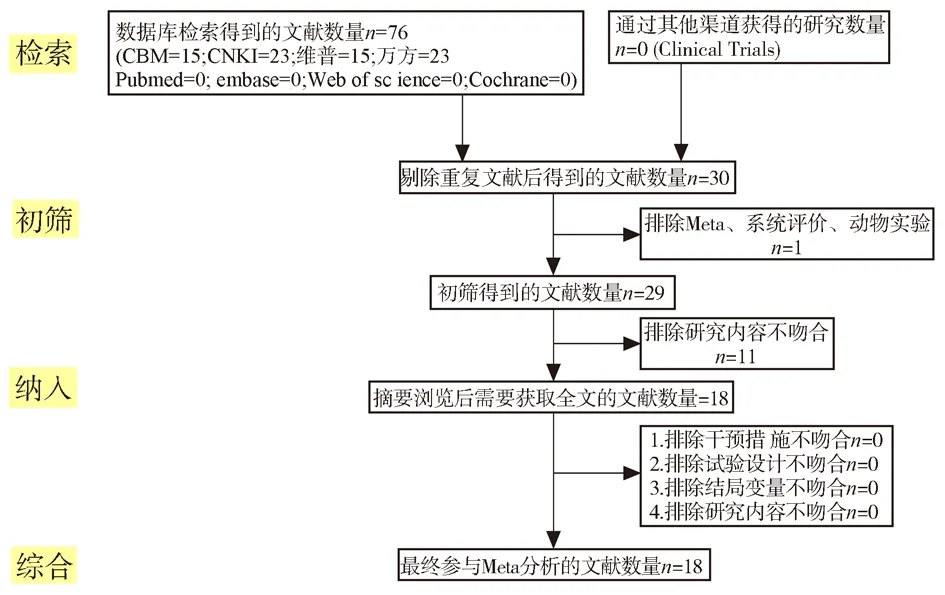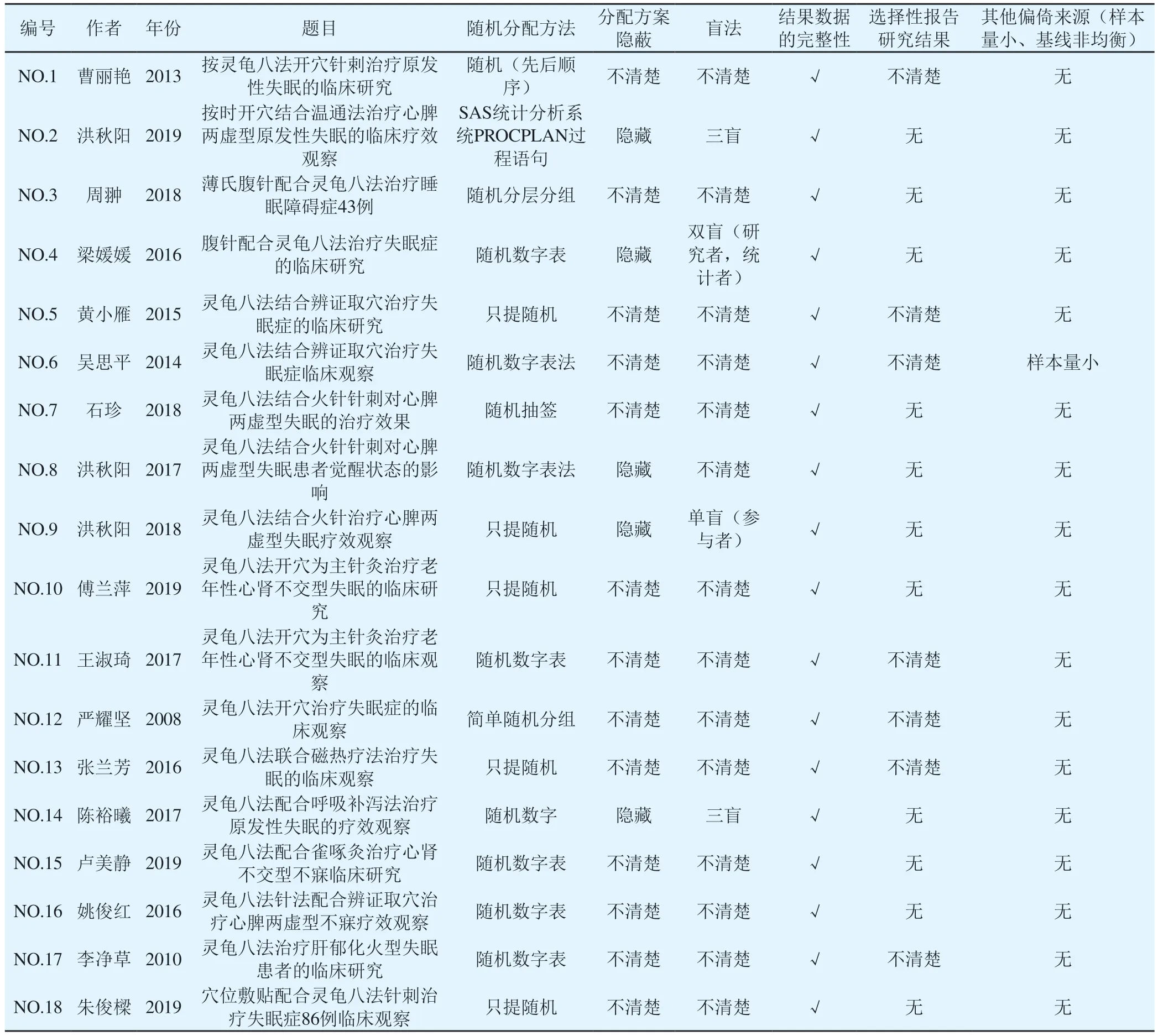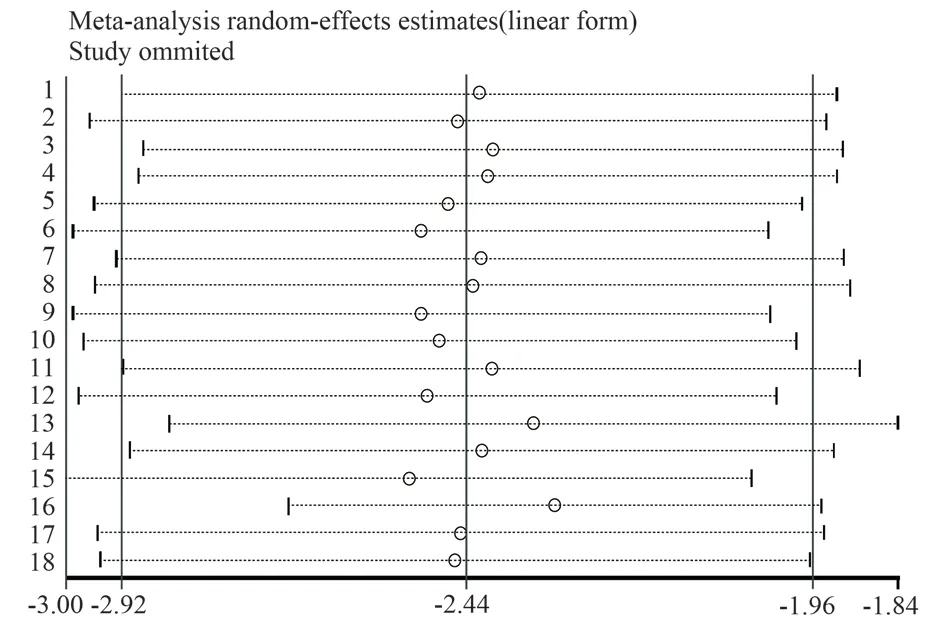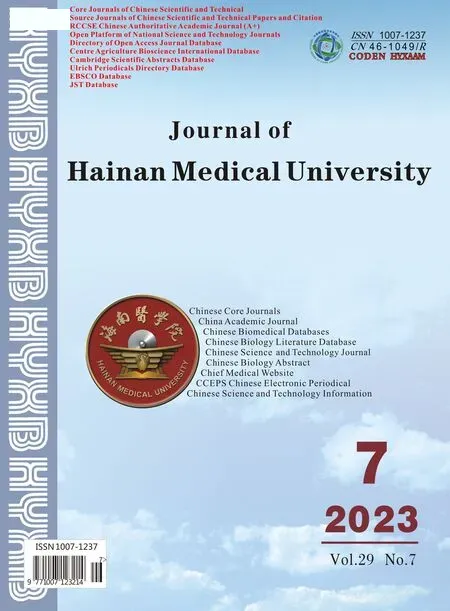A Meta-analysis of the spirit turtle eight method Acupuncture Therapy for Insomnia
CHEN Bo-xin, ZENG Nian-peng, KUANG Yu-lian, ZHAO Cai-jiao
College of Acupuncture and Tuina, Guangxi University of Chinese Medicine, Nanning 530000, China
ABSTRACT Objective: To systematically evaluate the efficacy and safety of the spirit turtle eight method acupuncture therapy in the treatment of insomnia, to better serve the clinic and provide reference ideas for the treatment of insomnia.Methods: Search CNKI, CBM, Wanfang,Weipu, China Clinical Trial Registry databases on the use of the spirit turtle eight method compared with others interventions to treat insomnia.The search period is from the library until August 1, 2021, two researchers will conduct independent quality evaluation and effect size extraction on the literature, and use STATA16.0 and Review5.3 to conduct Meta analysis and quality evaluation on the literature.Through screening, a total of 18 eligible documents participated in the meta-analysis, with a total of 1583 cases.Results: ①The effective rate of the spirit turtle eight method in the treatment of insomnia is higher than the control group[RR=1.213, 95%CI(1.155, 1.274), Z=7.71, P<0.01]; ②The Pittsburgh Sleep Quality Index(PSQI) score is lower than other acupuncture treatments [WMD=-2.33, 95%CI(-2.75,-1.91),Z=10.97, P< 0.01]; ③The one-month follow-up PSQI score after the treatment of insomnia by the spirit turtle eight method is lower than the control group [WMD=-3.263, 95%CI(-3.446, -3.080), Z=34.96, P<0.01]; ④No studies have reported serious adverse reactions in the treatment group and control group.Conclusion: Based on the current research, the spirit turtle eight method are better than the control group in the treatment of insomnia, and are suitable for clinical application.However, more high-quality clinical studies are still needed to prove its efficacy.
Keywords:
Spirit turtle eight method
Acupuncture
Treatment
Insomnia
Meta Analysis
1.Introduction
Insomnia is a frequently-occurring and common disease in daily life.A variety of reasons can induce insomnia, and common inducements include mental and psychological factors and the influence of some diseases.The consequences of insomnia are serious, including causing certain medical diseases[1], dysfunction,absenteeism, impaired attention and memory, and increased use of medical services[2-3].According to statistics, 4%-50% of the world’s population have sleep disorders of varying degrees, and 50% of patients with insomnia suffer from mental disorders[4].At present,the first-line treatment drugs for patients with insomnia are mainly benzodiazepines and non-benzodiazepines [5].It has been reported in the paper that although benzodiazepines and non-benzodiazepines can temporarily improve the sleep status of patients, long-term use of such drugs will cause patients to experience worse sleep quality as they take the drugs for a long time, and even drug dependence insomnia[6].
Traditional Chinese medicine has a long history of research on insomnia.In recent years, various schools of acupuncture and moxibustion have achievements in the treatment of insomnia.Wu Huihui et.[7] have done in-depth research on the law of selecting acupoints.The treatment method mainly based on the eight methods of the tortoise is developed on the basis of the theory of “The relationship between human and earth or sun is harmonious”, and the theoretical foundation of the visceral organs, yin and yang,meridians and collaterals.It fully integrates the Qi and blood flow regularity of the eight channels of the odd meridian in the human body and the timing characteristics of acupuncture, and its effect is significant [8].Many researchers have also conducted clinical trials on it, with good feedback.However, various clinical studies are relatively independent, and there is no systematic evaluation of its efficacy and safety.Therefore, based on the evidence-based medicine method, this study conducted a quality analysis and systematic evaluation of the paper that meets the inclusion criteria,in order to provide clinical decision-making basis for the treatment of insomnia with acupuncture therapy based on the spirit turtle eight method.
2.Materials and methods
2.1 Source of materials
Search CNKI, CBM, Wanfang, VIP, China Clinical Trial Registry database, published and unpublished but registered in the experimental registry of the spirit turtle eight method compared to conventional acupuncture intervention programs for the treatment of insomnia paper.
2.2 Search strategy
The Chinese search terms are subject terms such as “insomnia”,“Linggui Feiteng”, and “randomized controlled trial”.“sleeping and sleep disorders”, “difficulty falling asleep”, “sleep disorders”,“insomnia”, “insomnia”, “Spirit turtle eight method “, “Ling Turtle”, “Qing Jing Na Gua Method”, “Qing Jing Na Jia Method”“Randomized Controlled Study”, “Randomized Control”,“Random”and “RCT”are free words.The subject words and free words are connected by the Boolean logic operator “OR”, and the research objects, interventions, and research methods are connected by the Boolean logic operator “AND”.The search period is from the establishment of the database to August 1, 2021.
2.3 Inclusion criteria
The included paper must meet the following criteria: ①The research method belongs to a randomized controlled trial;②Insomnia is primary insomnia, and no other diseases cause it;③Acupuncture with the Spirit turtle eight method as the main intervention; ④The control group must use acupuncture therapy.
2.4 Exclusion criteria
①Repetitive paper; reviews, systematic reviews, Meta analysis;animal experiments and other non-randomized controlled trials.②Insomnia is non-primary and is caused by the original disease or underlying disease.③The intervention group used other acupuncture therapies other than the Spirit turtle eight method as intervention methods.④The control group was treated with drugs.⑤The diagnostic criteria are unknown.
2.5 Paper quality evaluation
Using the “Basis of Bias Risk Assessment”in Review Manager 5.3, the included paper will be evaluated based on the intervention reviews in the Handbook.There are 7 items in total, namely: random allocation method, allocation plan concealment, subject blind method, Researcher blinding, completeness of result data, selective reporting of research results, and other biases.Two investigators independently assessed the bias of the included studies according to the Handbook.If there is a disagreement, the third investigator will discuss the research after combining the opinions of both parties, and give the final risk bias.
2.6 Statistical processing
Use STATA16.0 software for statistical analysis of data.For binary variables, first perform heterogeneity test.P>0.1 and I2<50%indicate acceptable heterogeneity.Meta-analysis is performed using fixed-effects model.Fororfirst explore the source of heterogeneity, if the source of heterogeneity can be found, use random effects for meta-analysis, otherwise, give up meta-analysis.For continuous numerical variables, the baseline consistency test is performed first, and then the heterogeneity test operation is performed after the baseline is consistent.The count data selected RR as the effect indicator, and the measurement data selected WMD as the effect indicator, and the 95% confidence interval CI was calculated.Ifthe difference was considered to be statistically significant.
3.Result
3.1 Paper search results
A total of 76 results were retrieved in this study, including CBM(n=15), CNKI (n=23),VIP (n=15), Wanfang (n=23), and China Clinical Trial Center (n=0).After eliminating duplicate documents,eliminating reviews, systematic reviews, Meta analysis, eliminating animal experiments, reading titles and abstracts, eliminating documents that are not consistent with the content of this study,reading the full text and eliminating inconsistent intervention measures, unreasonable trial design, and inconsistent outcome variables , The research content does not match the paper, a total of 18 papers are included, and the screening flowchart is shown in Figure 1.

Fig 1 Comparison of the spirit turtle eight method to the conventional acupuncture treatment of insomnia literature screening flow chart
3.2 Basic characteristics and quality evaluation of included studies
This study included 18 papers[9-26], all of which were published documents, with a total of 1 583 cases, including 798 cases in the observation group and 785 cases in the control group.All 18 articles mentioned that there was no statistical difference in general data between the observation group and the control group (P>0.05).Modern medicine diagnostic criteria for insomnia are based on the“Chinese Mental Disorders Classification and Diagnostic Criteria”,with 11 papers using [9,11-14,17-18,20,22,25-26], and 3 papers [10,15,23] Using the diagnostic criteria of the United States (“Diagnostic and Statistical Manual of Mental Disorders”, the fifth edition of the American “Diagnostic and Statistical Manual of Mental Disorders”(DSM-Ⅴ), “Diagnostic and Statistical Manual of Mental Disorders”Fourth Edition), there are 1 Article[21] uses “ICD-10 Mental and Behavioral Disorder Classification Clinical Description and Diagnosis Essentials”, there are 3 articles[16,19,24] not mentioned.The diagnostic criteria of TCM are mainly based on the “Criteria for the Diagnosis and Efficacy of TCM Diseases and Syndromes”, with 10 articles using[9-15,17,24-25], and 5 articles[20-23,26] using the China Traditional Chinese Medicine Publishing House.Seven editions of“Traditional Chinese Internal Medicine”, “Acupuncture and Tuina Therapeutics”, “Guiding Principles for Clinical Research of New Chinese Medicines”, there are 3 articles[16,18-19] not mentioned.The basic characteristics of the included literature are shown in Table 1.The 18 included papers [9-26] all use random allocation methods,of which 5 papers[9,12,15,25-26] specify the method of hiding the allocation plan, and none of the other documents mention it.Blinding: One article[15] adopted blinding to participants, one article[12] adopted blinding to researchers, and two articles[10,26]adopted triple blinding.All papers results data are complete.There are 11 papers[10-12,15-16,20-21,23-26] mentioning that it has been approved by the ethics committee or its experimental design is rigorous, and the data is large.so, it is speculated that there is no selective report of results.Others papers unclear.One article[14] has the possibility of other biases due to its small sample size.In general,there is some degree of bias in the paper included in the study.The basic characteristics of the included papers are shown in Table 2.The risk of bias in the included paper is shown in Figure 2, and the summary of risk of bias is shown in Figure 3.

Fig 2 Analysis of the risk of bias in the treatment of insomnia with the spirit turtle eight method
3.3 Meta analysis of 3 outcome data
3.3.1 Clinical efficacy evaluation
A total of 16 studies[9-18,21-26] reported clinical efficacy.The heterogeneity analysis showed that there was no statisticalheterogeneity in the included paper (P=0.839>0.1 for Q test,I2=0<50%).Using a fixed-effect model, RR=1.213 (1.155, 1.274),and statistically significant Z=7.71, P<0.01, suggesting that the effect of spirit turtle eight method acupuncture on insomnia is significantly better than that of the control group.The curative effect of the therapy is 1.213 times that of the control group (P<0.01).The forest map is shown in Figure 4.By drawing a funnel chart to investigate whether there is publication bias in the 16 papers of this study, it is concluded that the funnel chart is symmetric (P=0.086>0.05 from Egger’s test), and there is no publication bias conclusion, which indicates that the conclusions of this study are accurate and reliable.The funnel diagram is shown in Figure5.

Tab 1 Basic characteristics of clinical research on the treatment of insomnia with spirit turtle eight method

Tab 2 Evaluation table of clinical research literature on the treatment of insomnia with spirit turtle eight method

Fig 3 Summary diagram of the risk of bias in the treatment of insomnia with the spirit turtle eight method

Fig 4 Meta-analysis forest chart of the evaluation of the clinical efficacy of spirit turtle eight method acupuncture therapy in the treatment of insomnia

Fig 5 The clinical efficacy evaluation of spirit turtle eight method acupuncture therapy in the treatment of insomnia is a funnel chart of publication bias
3.3.2 Pittsburgh Sleep Quality Index (PSQI)
A total of 18 studies[9-26] reported the Pittsburgh Sleep Quality Index (PSQI), and the baseline consistency test showed that the baseline differences included in the literature were not heterogeneous(I2<50%, Q-test P>0.1).The heterogeneity analysis showed that the included paper was heterogeneous (I2=80.3%, Q-test P<0.1).A sensitivity analysis of the 18 papers this time revealed that there was no research that had a significant impact on the heterogeneity.The report is detailed in Figure 6.Figure 6 clearly shows that deleting any one article did not cause a significant change in the results, so the sensitivity analysis did not examine the source of heterogeneity.Considering that there is a big difference in curative effect between drug treatment and acupuncture in the control group, a subgroup analysis was performed.
①The heterogeneity of the acupuncture group (I2=58.1%,P=0.002<0.1) is statistically significant, but it is only slightly heterogeneous.Considering the particularity of acupuncture treatment, due to the acupuncture technique and treatment time of the therapist The difference in opening acupoints caused by the difference of, the heterogeneity is within the acceptable range, so the random effects model analysis is used, and it is obtained that WMD=-2.33 (-2.75, -1.91), which is statistically significant (Z=10.97, P<0.01), the PSQI score obtained after the spirit turtle eight method acupuncture therapy intervenes insomnia is significantly lower than the conventional acupuncture therapy by 2.33.The forest map is shown in Figure 7.
②The heterogeneity of the drug group (I2=81.1%, P=0.005<0.1),the heterogeneity is high, considering that the control group uses different sedatives as the control, which is one of the reasons for the high heterogeneity, so, abandon the meta-analysis of this subgroup.By drawing a funnel chart to investigate whether there is publication bias in the 18 papers of this study, it is concluded that the funnel chart is symmetrical (P=0.832>0.05 from Egger’s test), and there is no publication bias, suggesting that the conclusions of this study are accurate and reliable.The funnel chart show in Figure 8.

Fig 6 Sensitivity analysis of spirit turtle eight method acupuncture therapy for insomnia

Fig 7 Meta-analysis forest plot of Pittsburgh sleep quality index in subgroup① of spirit turtle eight method acupuncture treatment of insomnia

Fig 8 The PSQI publication bias funnel chart of the spirit turtle eight method of insomnia
3.3.3 PSQI score at 1 month follow-up after treatment
A total of 3 studies[12,15,24] evaluated the sleep quality of patients one month after treatment and gave a PSQI score.Heterogeneity analysis showed that there was no heterogeneity in the included literature (I2=0, P>0.1 for Q test).The fixed effects model was used,and the combined effect size WMD= -3.263 (-3.446, -3.080), which was statistically significant.Z=34.96, P<0.01, suggesting that in the 1-month follow-up of patients after treatment, the curative effect of spirit turtle eight method acupuncture therapy on insomnia was significantly lower than that of conventional acupuncture therapy by 3.263.The forest map is shown in Figure 9.Egger’s test obtained P=0.537>0.05, no publication bias conclusion, suggesting that the conclusion of this study is accurate and reliable.

Fig 9 Meta-analysis forest diagram with a large PSQI score for the treatment of insomnia with the spirit turtle eight method
3.3.4 Adverse events
Only 2 of the 18 studies[10,26] reported adverse events.In Hong Qiuyang 2019, a patient in the treatment group had mild subcutaneous hematoma, and Chen Yuxi 2017 in the treatment group had 2 cases of stasis after needle initiation.But pressing for 2-3 minutes, the bruise disappeared.In the remaining studies, there were no reports of other accidents such as stuck needles, fainting needles,pain after acupuncture, broken needles, local infections and injuries.It shows that the spirit turtle eight method is a safe and reliable method to treat insomnia.
4.Discuss
Insomnia, the name insomnia in traditional Chinese medicine, is also called “cannot sleep.”“Origin of Chinese Characters”said:“Sleep: lying down.From the province, not sound [27]”.If you sleep,you cannot sleep or sleep without rest.Ancient physicians had their own discussion on its pathogenesis, “Miraculous Pivot”: “When the yang is exhausted, the yin is full, and the eye will be obsessed; when the yin is exhausted, and the yang is full, it will be full”[28].“Golden Chamber Suspended Solution”: “Yang Qi is hidden, so you can sleep soundly.The yang root leaks but does not hide, so you can’t sleep.”He also said: “Yang does not root yin, so irritable, do not sleep lying down”[29].“Four Sacred Experience “: “Yang mysteriously hides, then sleeps willingly and remembers well, and yang vents but does not hide, so it is also forgetful and insomniac”[30].The spirit turtle eight method are based on the Eight Trigrams of the Nine Palaces, and its theoretical system can be traced back to the “Book of Changes”[31].“Compendium of Acupuncture and Moxibustion“further recorded that “the Qian belonged to Gongsun originate Neiguan, Xun near Zhen belong Waiguan, Li local in Lieque and Kun local in Zhaohai, Houxi and Shenmai belong Dui and Kan”[32].the spirit turtle eight method of the tortoise compare the human body to nature.According to the characteristics of the change of yin and yang at twenty-four o’clock, the eight-channel junction is used as the cardinal to adjust the yin and yang qi and blood of the human body,in order to “yin and yang secret, the spirit is the cure”.As the “Su Wen Suspended Solution “put it: “Covering the essence and soul of yin, it is constrained and hidden, and the soul is yang, its grows stronger, the spirit of the spirit grows, the person will be magnificent,and the spirit of spirit will be agglomerated and stored.Then people sleep soundly”[33].Through the acupuncture therapy of the spirit turtle eight method, the Qi and blood of the eight meridians of the stored and irrigated Qi meridians can flow to the twelve meridians.It makes Yinxue able to conserve the spirit, regulate the camp and guard, and make people feel at ease.
Modern medicine has also done in-depth research on the mechanism of the spirit turtle eight method treatment.Through animal experiments, it has been found that acupuncture can regulate the levels of Glu and GABA in the brain, and then achieve the purpose of regulating the sleep cycle-wake cycle[34].The spirit turtle eight method acupuncture have a balanced and coordinated effect on the cells of the whole body and guide the internal environment to a good effect.Our research team has done a number of studies for this.Moxibustion can strengthen the memory ability of Alzheimer’s rats, it can also reduce the activity and gene expression of Bax in dementia rats, and increase the activity and gene expression of Bcl-2[35].An animal experiment on the liver of a rat even showed that the Rb protein content in the liver of rats treated with the spirit turtle eight method acupuncture was significantly higher than that of the normal group[36].It can be seen that the spirit turtle eight method opening acupoints can create a good internal environment, promote the regulation of Glu and GABA levels in the brain, and guide positive changes in the sleep cycle-wake cycle.
There are still limitations and deficiencies in this study:some documents did not mention blinding and allocation plan concealment.In addition, the few follow-up studies and the inconsistent intervention measures also make this Meta study have limitations and deficiencies.Although the current researches on the treatment of insomnia by acupuncture and moxibustion at home and abroad have good therapeutic effects, due to the existence of a certain degree of one-sidedness, it is difficult to further improve the clinical efficacy of acupuncture and moxibustion in the treatment of insomnia.For example, there are many classifications of sleep theory in traditional Chinese medicine, and the research is rich,but relatively fragmented, and the in-depth mechanism research is relatively lack; the lack of uniform efficacy standards between clinical studies is not conducive to the horizontal comparison between the studies; the treatment of PI under different theories The method features and advantages need to be explored in depth[37].In order to provide more solid theoretical support in the treatment of insomnia with the spirit turtle eight method, in the future, the spirit turtle eight method can be used to conduct research tests on human neurophysiology, brain electrical activity, and sleep monitoring.Indepth research on the mechanism of sleep disorders with the spirit turtle eight method, in order to explore the mechanism; in-depth exploration and exploration of the effect of opening and closing points at different times and different results of opening and closing points under the spirit turtle eight method to find out the best Good open point combination.
In summary, the results of this study show that the spirit turtle eight method acupuncture therapy is effective in the treatment of insomnia.It can significantly improve the symptoms of insomnia and improve the quality of sleep, and there are no obvious adverse reactions.Some studies have been conducted.According to the follow-up, it can be found that the sleep quality of patients within 1 month is better than that of the control group by adopting the spirit turtle eight method acupuncture.However, due to the limitations of the included literature, this study still needs more high-quality, largesample clinical studies.
Author’s contribution description:
Chen Boxin:First author, check data, review and evaluation, metaanalysis and paper writing
Zeng Nianpeng:Literature quality evaluation, data screening
Kuang Yulian:Paper quality evaluation, data screening
Zhao Caijiao:Corresponding author, guidance and suggestions for this research
 Journal of Hainan Medical College2023年7期
Journal of Hainan Medical College2023年7期
- Journal of Hainan Medical College的其它文章
- The research status of Asprosin and its application prospect in the protection of myocardial injury
- Research progress on effective chemical constituents of Sijunzi Decoction and mechanism of prevention and treatment of digestive system diseases
- Network Meta-analysis of nerve block combined with Chinese medicine for lumbar disc herniation
- Bone palsy eliminates granules to regulate Wnt/PI3K-AKT signaling pathway and intervene in hormonal osteonecrosis of the femoral head in rabbits
- Electroacupuncture on hippocampal CREB/BDNF/TrkB in depressive rats effects of signaling pathways
- Effect of Qingjin Huatan Decoction on transferrin and Iron regulatory protein in COPD rats
